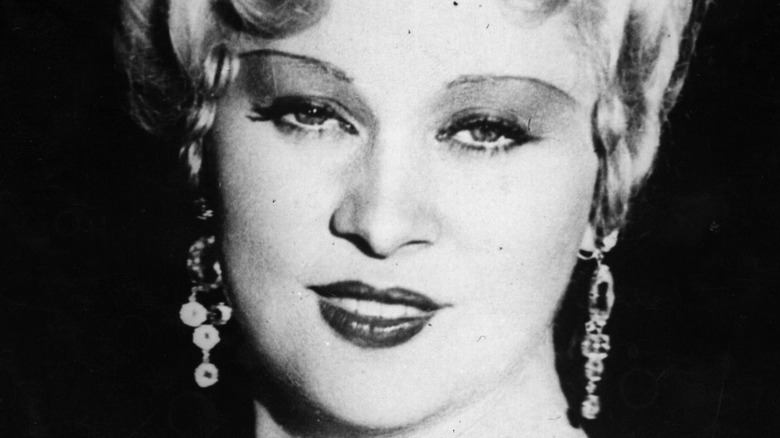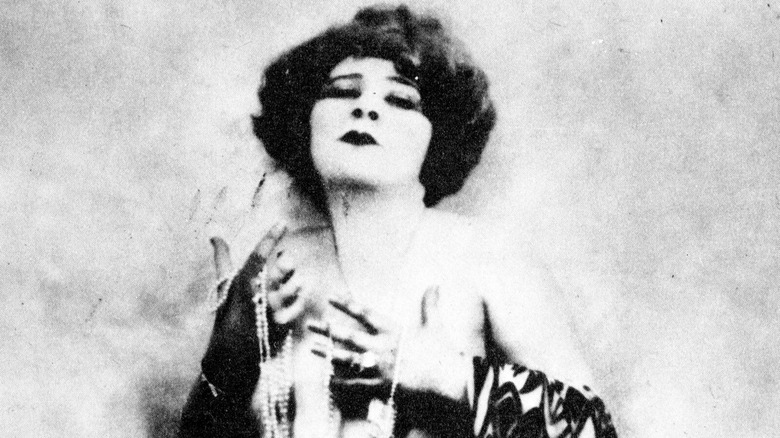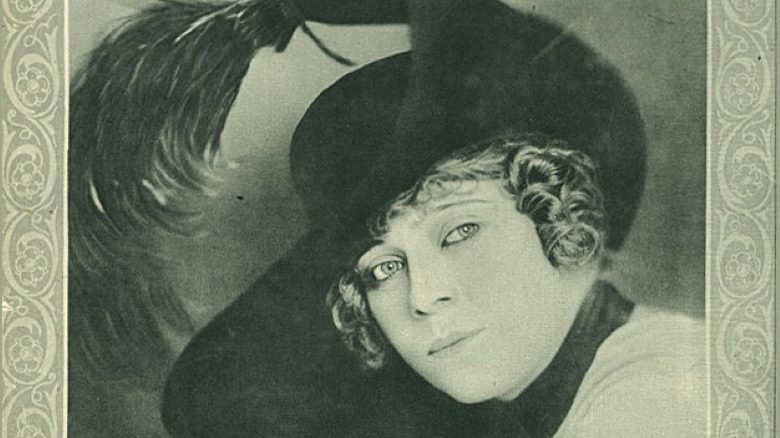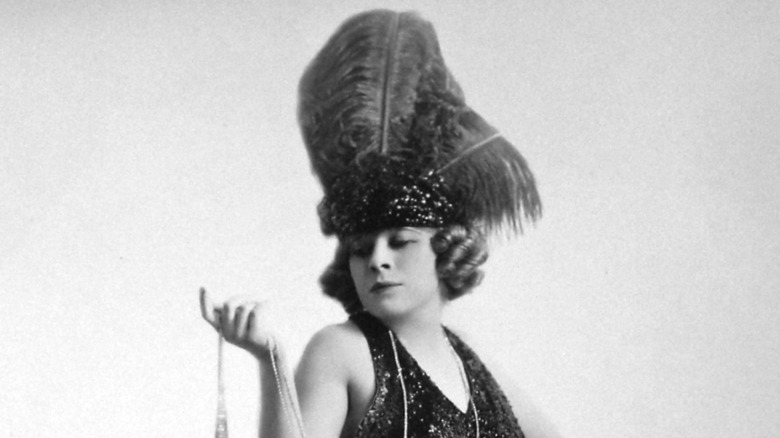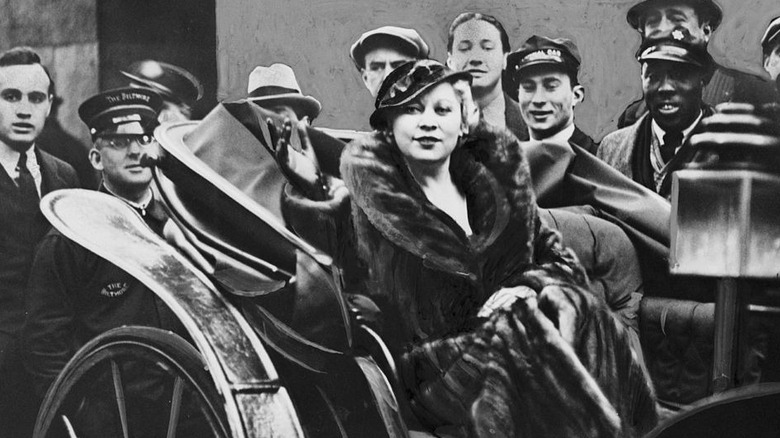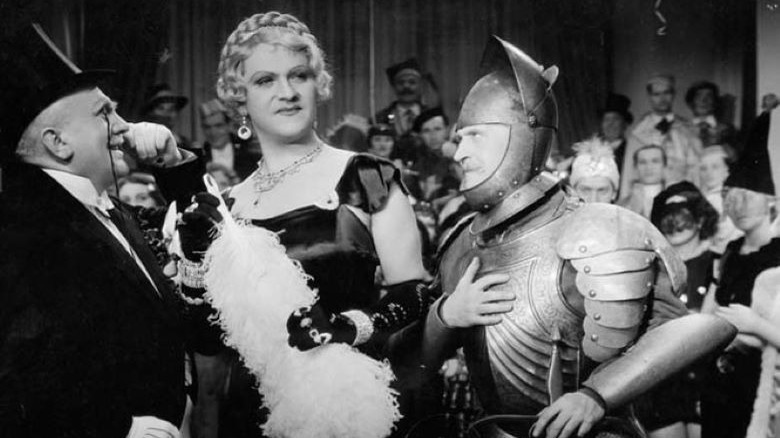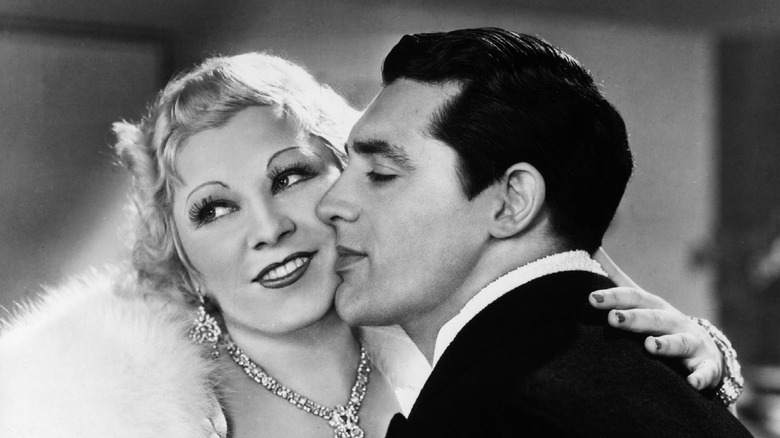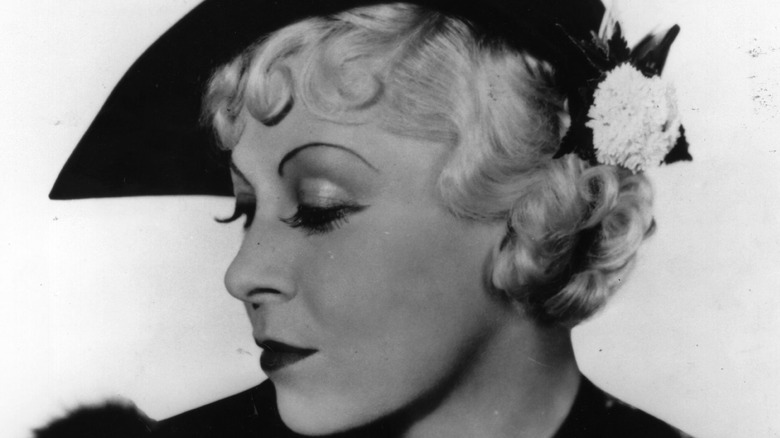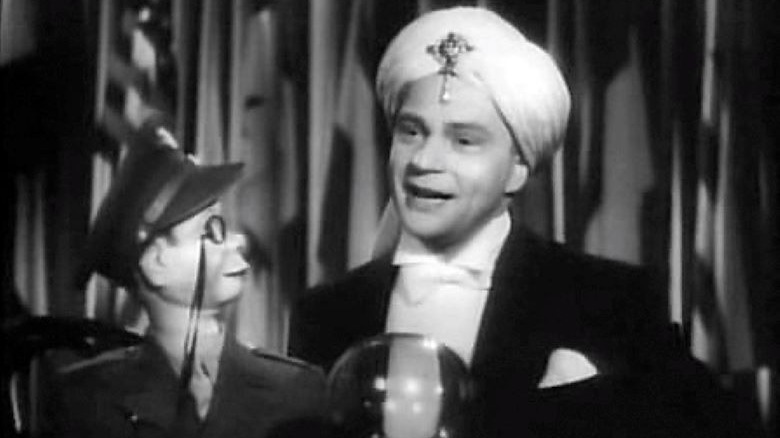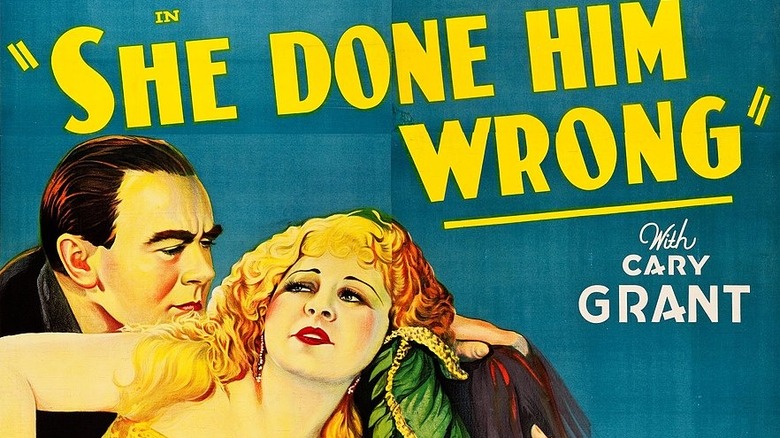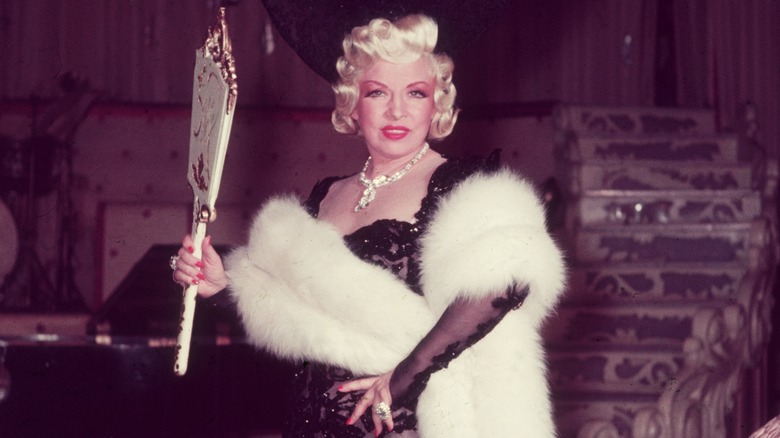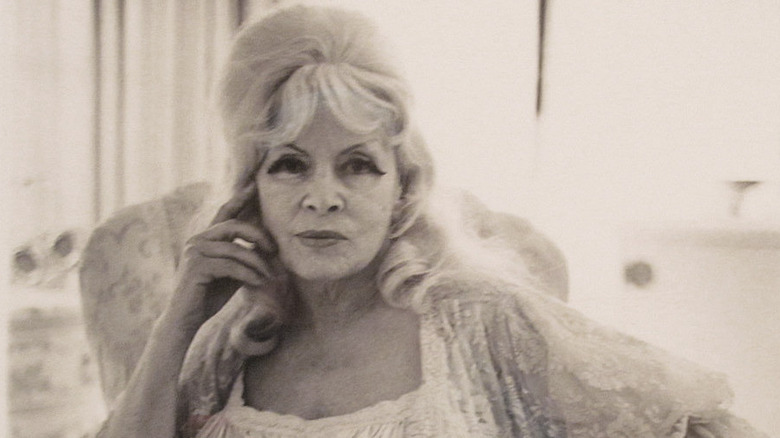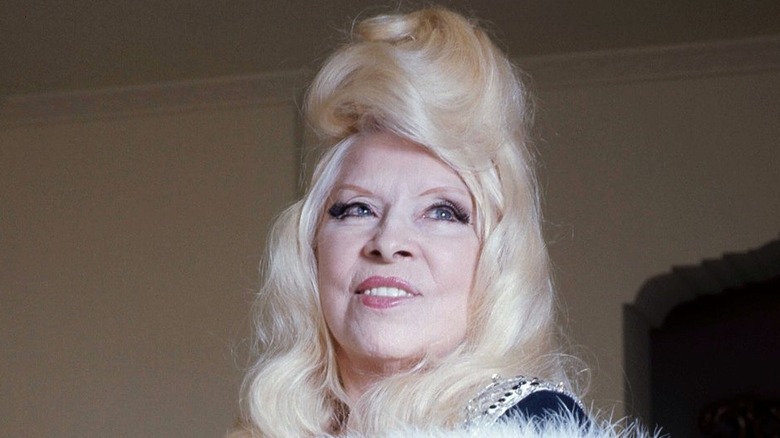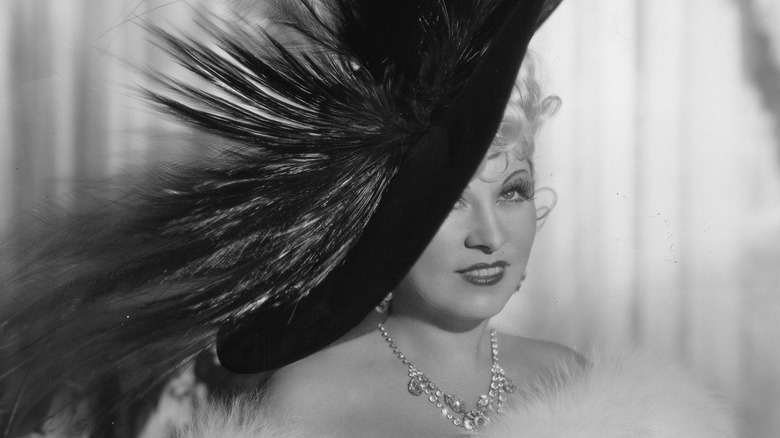The Untold Truth Of Mae West
Mention a name from history, Mary Jane West, and nary a flicker of recognition will appear. Say the iconic name "Mae West," however, and eyebrows will raise. A sexy siren of the screen, Broadway, radio, and even television, West was the epitome of a wicked femme fatale. West's status as a superstar in her time, however, came at a cost — although she hardly mentioned her troubles in her autobiography, "Goodness Had Nothing To Do With It." American Heritage magazine's Susannah McCorkle writes that West, in the third person, explained that her "fans don't want Mae West to have problems and have to struggle. Mae West always triumphs."
Mae West was a staunch believer in free speech and abhorred censorship, says Cleveland State University's Charlotte N. Toledo. She also supported gay rights when few others dared to. Clearly, there was more to this lady than the average celebrity. West didn't just parade through Hollywood fluffing her feather boas. She did it while declaring, "When I'm good, I'm very good. But when I'm bad I'm better." She was quite open about sex as it was in the early 20th century, used satire to seduce her enemies, and exhibited a boldness few other actresses dared to do. Read on for the untold truth of the fabulous Mae West.
The birth of a bombshell
According to PBS, Mary Jane West was born in Brooklyn, New York, in 1893. At the young age of 9, she debuted as "Baby Mae," singing "Movin' Day" at Brooklyn's Royal Theater. Vanity Fair tells of her demanding a spotlight. When none appeared, as she took the stage, Baby West stamped her foot, demanding, "'Where is my spotlight!' The young lady got what she wanted as the audience applauded. By the time West was 18 years old, she had worked for Hal Clarendon's stock theater company and actor William Hogan. She had also married fellow actor Frank Wallace, but the Prescott Evening Courier reported that she left him in 1914.
Mae West wasn't cut out for marriage, but she was cut out for the stage. Between 1911 and 1915, she performed at the Folies-Bergere Theater, made a vaudeville tour, performed in "Winsome Widow" produced by Florenz Ziegfeld, and debuted her own solo comedienne act. She also married musician Guido Deiro, confirms the City University of New York, and had a long-term affair with her manager, Jim Timony, beginning in 1916. According to "Mae West: A Biography" by George Eells and Stanley Musgrove, this is the same year that West used a pseudonym to masquerade as a man on stage.
Mae West and the uproar over the Shimmy Shawabble
By 1918 Mae West was truly coming into her own. In its review of her latest show, "Sometime," the New York Tribune commended her performance but noted that the end was "marred by vulgarity." What the newspaper meant, explains author Jon Tuska in "The Films of Mae West," was that West danced the "Shimmy Shawabble," a quite risqué and wriggly dance number. The Washington Post's Dennis Drabelle quoted one critic who equated the dance to "an attempt to get out of a straitjacket without the use of the hands." Yet West somehow conquered, and on Christmas day in 1918, says PBS, she was featured on the cover of the New York Dramatic Mirror.
Why was Mae West so unique to her audiences? Encyclopedia.com rightly surmises that the actress's costumes consisted mainly of "flashy and tight-fitting clothing" and huge fancy hats. Images of the lady reveal a swanky, voluptuous figure. Furthermore, Criterion writer Farran Smith Nehme says West's whiskey voice had a "slinky contralto drawl" to it that was irresistible. A 2020 American Masters feature about her rightfully surmises that Mae West "climbed the ladder of success wrong by wrong," but she did it well. And as her career flourished, she decided to take the helm and begin writing her own plays.
She dared to write plays about sex
Now that she was officially famous, Mae West began writing a series of play scripts. Vanity Fair quotes her as explaining, "I became a writer by the accident of needing material and having no place to get it." The Library of Congress lists 13 scripts Mae wrote beginning in 1921 and spanning over the next 40 years. Some were successful, while others shocked the nation. For West, writes Lillian Schlissel in a piece in Women's History Review, writing about the seamier side of life was more exciting. With titles like "The Hussy" in 1922 (ghost-written by playwright Adeline Leitzbach), combined with her notorious sex life (per San Diego Reader), both the media and the public were becoming aware of the siren's bawdy lifestyle.
"The Hussy," unfortunately, never made it to the stage. But "Sex" — written in 1926 under the nom de plume of Jane Mast (per History Matters) and starring Mae as a sex worker — did. New York Magazine verifies that the play was panned as "a crude, inept play," but when another critic talked of "one torrid love scene," audiences couldn't get enough. The Indianapolis Times reported that the play was a box-office success. As for Mae West, she was far from finished with her stint as a playwright.
Mae West, the Broadway jailbird
On February 7, 1927, the Seward Daily Gateway reported that Mae West's sister, Beverly West, had just recently penned her own "sex" play and was arrested in Boston. The crime? Beverly and her producer, Edwin Elsner, were caught sharing a hotel room. Ironically, just two days later, Manhattan New York Chief City Magistrate William McAdoo swore out arrest warrants for the entire cast of "Sex," including West. The Smoking Gun offers the complete affidavit on the affair, including a play-by-play rundown of the show. McAdoo described the play as an "obscene, indecent, immoral and impure drama."
The Evening Star clarified that the arrests were not made until "the final curtains fell." In the same article, mention was made of "The Drag," West's scandalous play about gay men, which the paper apparently did not know was also written by her (per Playbill). A later article in the Evening Star confirmed that West was fined and sentenced to 10 days in jail. Lillian Schlissel writes in "Three Plays by Mae West" that the actress rode to jail "in an open car carrying armloads of white roses" and was allowed to wear her silk underwear while incarcerated. She also donated a thousand dollars to the new Mae West Memorial Library at the jail. Now, she was more famous than ever.
She was a premier champion of women and gay rights
Upon her release from jail, Mae West immediately set about promoting "The Drag." It's her tribute of sorts to the gay men she worked with. In fact, says author George Chauncey in "Gay New York," West had "patterned" her own celebrity persona after female impersonator Bert Savoy. In turn, female impersonators like Eugeniusz Bodo (pictured), imitated her. The Guardian submits that West saw the struggles her gay friends went through and empathized with them. Unfortunately, "The Drag" was shut down before reaching New York. A rewrite of the play, "The Pleasure Man," only ran for three days, according to Playbill.
Today, Mae West's efforts are recognized as her way of explaining the very real repercussions of modern society refusing to accept the LGBTQ+ way of life. As for her triumphs on behalf of women's liberation (which wouldn't become a thing until the 1960s, says Britannica), West was just trying to make it in a man's world. "She didn't need women's liberation," proclaims the Las Vegas Review-Journal, "she freed herself." Indeed, the brassy, outspoken comedienne used sex to propel her career and did well. West's next play, "Diamond Lil," was a smashing success. The play "gives new visions to women — and also to men," crooned the Waterbury Democrat.
Her first movie production was nominated for an Oscar
In his biography, "Mae West: Empress of Sex," Maurice Leonard writes that West received the offer of a two-month contract from Paramount in 1932. She would be paid $5,000 a week. According to IMDb, her first role was the character of Maudie Triplett in "Night After Night." Her co-star was George Raft, with whom West was intimately familiar with from "Diamond Lil." It was a minor role, but with a memorable, ad-libbed line from West. A coat check girl compliments Maudie, "Goodness! What lovely diamonds!" West tailored her character's response: "Goodness had nothing to do with it, dearie."
Mae West's next movie was a real humdinger. It was titled "She Done Him Wrong" and was based on "Diamond Lil." Mae's co-star was none other than actor Cary Grant. Author Randy Skretvedt's article at the Library of Congress explains that Will H. Hays of the Production Code Administration once claimed that "Diamond Lil" was such a scandalous play that it would never become a movie. Both Mae West and Paramount proved him wrong, changing the name of the lead character to "Lady Lou." The movie was a great success and even earned a nomination for outstanding production — a precursor to best picture — at the 1934 Academy Awards.
Mae West was vehemently against censorship
Between 1932 and 1977, Mae West was only in a dozen movies (via IMDb). But make no mistake, the lady was busy, largely due to her triumphs over those who tried to censor her. "I believe in censorship," she once quipped in her husky voice. "After all, I made a fortune out of it." Indeed, the lady's mission was to educate others about the forbidden subject of sex, and she did it with comic genius. On the more serious side, Charlotte N. Toledo quotes Mae as explaining, "Because of narrow-minded censors and silly taboos, the people are unable to learn truths they are starving for."
For much of her career, Mae West managed to evade the Production Code Administration's attempts to downsize her sexuality and racy one-liners, says Gabrielle Iorio of Columbia University. Time after time, the administration would write to Paramount asking them to downplay West's voluptuous figure, clingy clothing, and implied references to sex. And time after time, West and the studio would refuse their requests. Not until 1935, says UCLA Library's Film & Television Archive, did they give in — but West's characters were an obvious "stifled version" of her persona. Even so, the actress did continue wisecracking and singing swimmingly through several more roles.
She was banned from radio for naughty banter
The year 1937 was rocky for Mae West. Long-ago husband Frank Wallace showed up and sued her for a portion of her earnings, according to the Brownsville Herald. But the Imperial Valley Press reported that the actress denied ever being married, stating, "I've never met Mr. Wallace." Finally, West finally admitted she had married Wallace (via The Daily Independent). She also informed the court that the two had never lived together and that Wallace had remarried in 1916. Around this same time, West's next movie, "Every Day's a Holiday," hit the theaters as she was invited to appear on radio for the National Broadcasting Company, according to scholar Matthew Murray.
If NBC was expecting an eloquent performance by the actress, they were in for a surprise. When West opened her mouth on the Chase & Sanborn Comedy Hour, Charlotte N. Toledo verifies that her skit about Adam and Eve was quite risqué. According to Old Time Radio Downloads — which features the original broadcast — the skit, written by Arch Oboler, caused a big uproar. After the skit, West bantered with ventriloquist Edgar Bergen's dummy, Charlie McCarthy. But her comments were so racy that the comedienne was banned from radio for 15 years, beginning in 1938.
Mae West gave a steamy performance with Rock Hudson at the Oscars
Since she was very young, Mae West had been singing onstage (per Britannica), and Criterion notes that some of her songs "originated in Black clubs." Yet, unlike other white artists, Mae always made sure to give credit where it was due. Not until 1933, however, did she actually sing on film, in "She Done Him Wrong," says IMDb. The University of Santa Barbara also documents her as recording her first record, "My Old Flame," with the Duke Ellington Orchestra in 1934. For the next several years, Mae continued singing in her movies and on stage. But her 1958 performance at the 30th Annual Academy Awards with actor Rock Hudson just about brought the house down.
Life Magazine, which explains that the awards show had only aired four other times up to that point, captured a telling image of Mae West and Hudson during a steamy rehearsal in front of Academy President George Seaton. And when the duo took the stage, the audience went absolutely wild, especially at the end of the number when Hudson planted a voluptuous kiss on Miss West. Mae continued recording over a dozen albums and singles throughout the rest of her career, according to Discography.
Her interview on CBS was deemed too hot to handle
Aside from an uncredited appearance in 1933's "Hollywood on Parade" (per IMDb), Mae West had never appeared on live television before her 1958 performance at the Academy Awards. In May of 1959, she made her second appearance as a guest on "The Dean Martin Show" (per Alamy). But an interview with her on CBS's "Person to Person," which took place in her Hollywood apartment, never aired. The Free Lance-Star reported that a spokesman for the network termed her answers to questions as "too hot to handle." Mae was understandably upset. "The gentleman said when he called that he hoped I wouldn't be disappointed," she commented. "Well, of course — but I'm sure my public will be more disappointed."
Mae needn't have worried. She had already been featured in a CBS documentary, "The Twentieth Century," and would continue to bear mention in many more. Meanwhile, she made a guest appearance on "The Red Skelton Comedy Hour" in 1960, "Mister Ed" in 1964, and was interviewed by talk show host Dick Cavett in 1976. In 1994, 14 years after her death, Mae was also the subject of "Mae West and the Men Who Knew Her," wherein she was recognized for her efforts to change how America viewed sex, LGBTQ+ rights, and race.
She was the self-proclaimed Daughter of the Sexual Revolution
The 1960s, according to History, were a "tumultuous" time what with civil rights, the Vietnam War, political assassinations, and an "emerging 'generation gap.'" But Mae West, now nearing her 70s, met it all head-on. Political author Carl Anthony writes that West was now a veteran nightclub act in Las Vegas and showed no signs of slowing down. When a reporter dared ask her what she thought of the sexual revolution, the performer shot back, "Think of it?! I invented it! My God! I was the original Daughter of the sexual revolution!"
Indeed, West happily embraced the new rock 'n roll phenomenon, says Susannah McCorkle in American Heritage. At the ripe age of 73 years, she hired a garage band, Somebody's Child, to record a rock n' roll album with her. Her renditions of hits like "Great Balls of Fire," "Twist and Shout," and even the Doors' "Light My Fire" (which you can hear on YouTube) did not go unnoticed. Now, a whole new generation embraced Mae West's films and albums. The Beatles' cover for their 1967 album, "Sergeant Pepper's Lonely Hearts Club Band," even included her face on the collage cover, and she was voted "Woman of the Century" by UCLA students in 1971.
She wrote a book of advice for women in the '70s
Mae West not only wrote plays but also several books, beginning in 1931 with "The Constant Sinner," aka "Babe Gordon." Rowman & Littlefield explains how West's character, Babe Gordon, is a worldly femme fatale who uses her sex appeal to get what she wants — much like Mae herself (via Biblio.com). More books would follow: "Diamond Lil" in 1932 and Mae's autobiography, "Goodness Had Nothing To Do With It," in 1959. The book "captured her style precisely," says Britannica, which explained the title was her signature retort from her first film role so long ago.
In 1975, an older but still hip Mae West penned a new book, "Mae West on Sex, Health, and ESP," which was published by W.H. Allen of London but is now out of print. Other writers contributed to the finished product, and the book is fairly rare today; Abe Books is charging over $200 for a used copy. Her final book, "Pleasure Man," was also published in 1975. Other tributes to the lady include Lillian Schlissel's 1997 reproduction of Mae's early plays in 1997's "Sex, The Drag, and the Pleasure Man," which the Observer says "proves that she was more complex than her movies suggest."
The legacy of the Mae West
During the 1970s, Mae West appeared in two more movies. The first, "Myra Breckinridge," was a comedy about a man who has a sex-change operation and goes to Hollywood. But Rotten Tomatoes reviews cared little for the work of director Michael Sarne. In West's last film, "Sextette," the 87-year-old's co-stars included Alice Cooper, George Hamilton, Ringo Starr, and Tony Curtis. The whole movie, according to American Masters, was a totally senseless yet hilarious romp. Actress Natasha Lyonne calls it a "radical power move — very, very rare." In her own way, the shock value of the film was West's final say about America's askew values.
In 1980, the Los Angeles Times reported that the legendary actress had died at her Hollywood apartment after a stroke. At her bedside were her longtime companion Paul Novak, her fan club president Dolly Dempsey, as well as a priest who gave Mae's last rites. Per the Los Angeles Times, Novak vowed to "give her the greatest Hollywood funeral we've ever had." But Novak changed his mind, and UPI reports that her funeral was a quiet, invitation-only affair at Forest Lawn Memorial Park instead. Today, according to Find a Grave, Mae West rests in her family's mausoleum in Brooklyn. She is gone but not forgotten; in 2020, PBS's American Masters produced "Dirty Blonde," a documentary about West's illustrious life and career.
